窗体顶端
In the grand narrative of the People's Republic of China’s development, the “Ten Great Buildings” in its capital Beijing stand as cultural landmarks of the era, distinguished by their unique ethnic style and modern aesthetics. Behind the decorative designs of these architectural marvels bears the imprint of Mr. Wen Lianchang’s dedicated craftsmanship, from the silk curtains of the Great Hall of the People to the grand wrought-iron floral screen of the Cultural Palace of Nationalities; from the carpets of the Diaoyutai State Guesthouse to the bronze ornaments of the National Museum of China (originally known as the National Museum of Chinese Revolution). His designs not only carry the profound heritage of ethnic patterns, but also outline the threads of the era with innovative strokes. As a key participant in the decorative design of the capital’s “Ten Great Buildings” and one of the pioneers of China’s dyeing and weaving education, he seamlessly integrated artistic practice with teaching, nurturing countless talents in art and design. With a lifetime of persistence, he brought traditional Chinese pattern art from the depths of history into modern life, allowing ethnic aesthetics to radiate brilliance amid the tides of time. This article invites you into Wen Lianchang’s artistic journey, exploring how he wielded design like a brush to paint a flowing epic of aesthetics.
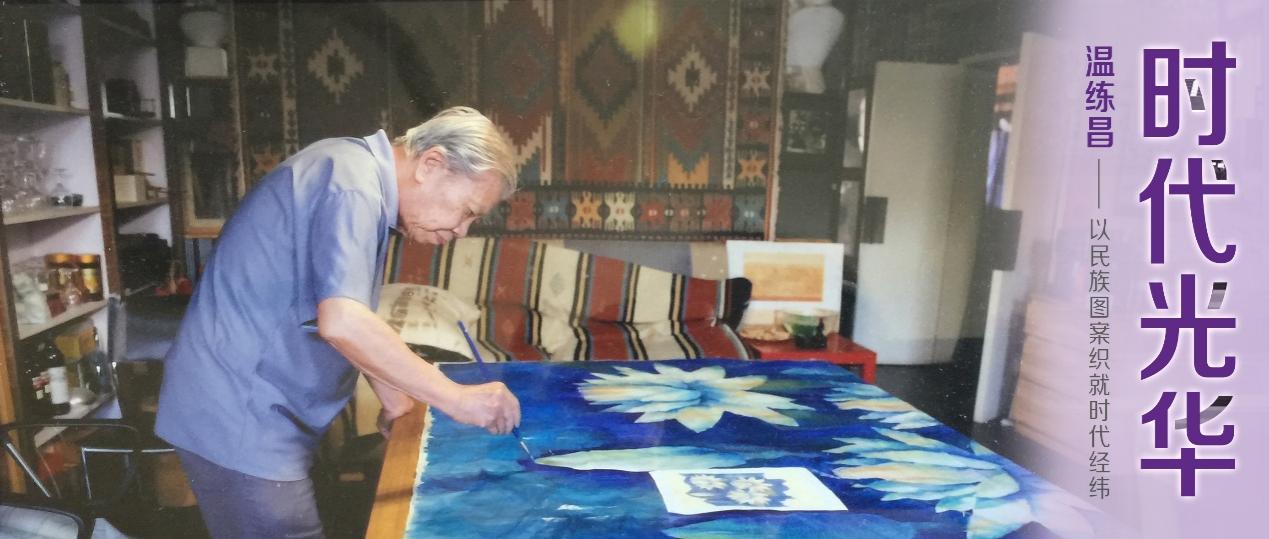
Splendor of the Times: Artistic Imprints in Beijing’s “Ten Great Buildings”
An Exclusive Interview with Wen Lianchang
Amid the monumental journey of the People's Republic of China’s development, Wen Lianchang left a profound legacy in national development, education, and cultural heritage with his exceptional design talent and deep patriotic devotion.
From his magnificent contributions to the design of Beijing’s “Ten Great Buildings” to his pioneering innovations in dyeing and textile education, from preserving traditional ethnic culture to laying the foundation for modern design aesthetics, Wen dedicated himself to designing for national development, contributing to education, and safeguarding cultural heritage. He wove his personal artistic pursuit tightly into the broader narrative of China’s rejuvenation.
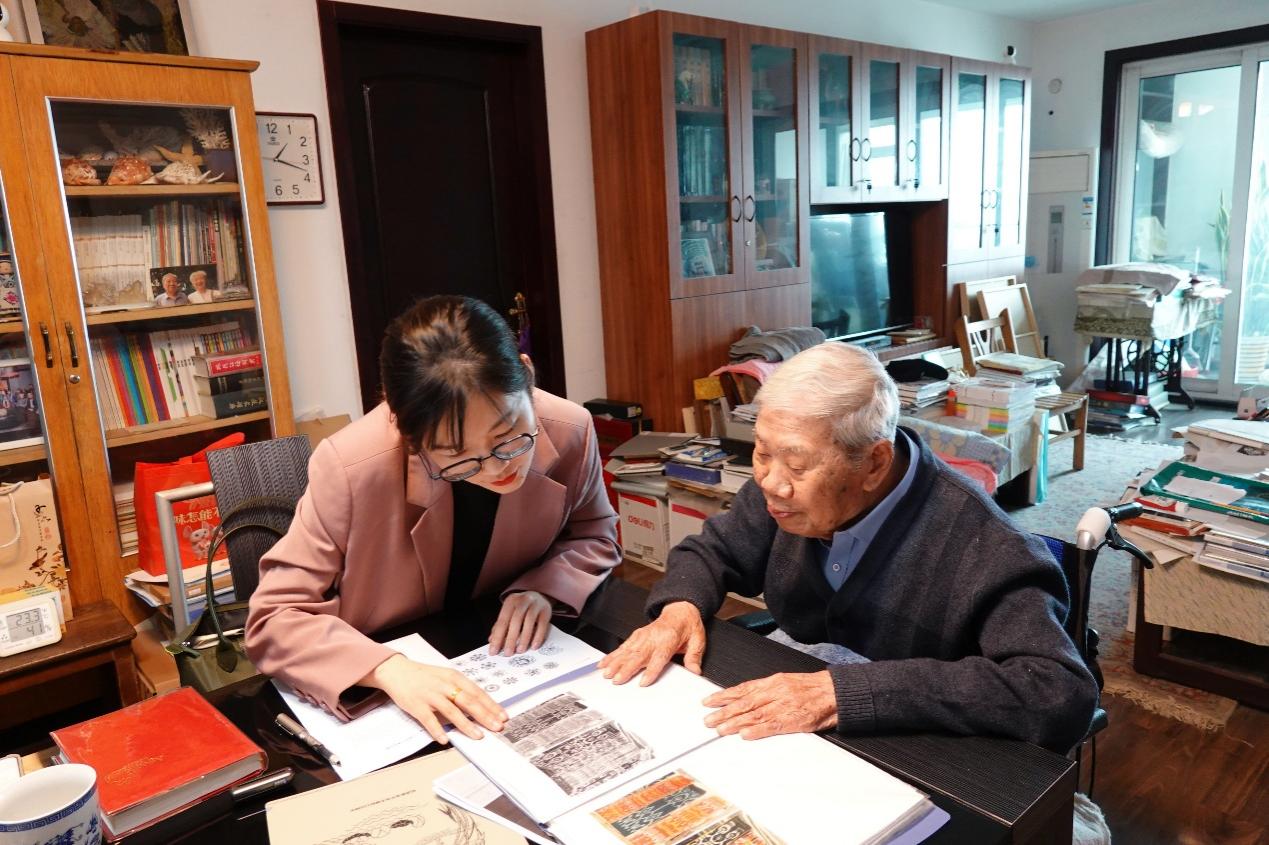
An interview with Mr. Wen Lianchang
Design for National Development
In December 1927, Wen Lianchang was born on Sabang Island, off the northern coast of Sumatra, Indonesia. At the age of seven, he crossed the oceans to return to his ancestral hometown of Meixian County in Guangdong Province of China for education. At sixteen, he was admitted to Guangdong Provincial Meizhou Middle School with outstanding academic performance. Boasting a time-honored tradition in art education, the school had nurtured great artists such as Lin Fengmian whose students served as instructors specializing in manual arts and painting at the school. It was here that Wen first received systematic training in fine arts and the seed of artistic passion began to sprout within him.
In the autumn of 1948, he was enrolled in the Department of Applied Arts at the National Hangzhou Art College (renamed in 1950 as the East China Branch of the Central Academy of Fine Arts). “The department was home to numerous luminaries—Mr. Guan Liang taught sketching, while Mr. Lei Guiyuan, Mr. Chai Fei, and Mr. Cheng Shangren offered courses in pattern design…” To this day, Mr. Wen remains profoundly grateful for his mentors’ dedicated instruction. Their teachings laid a solid foundation for his artistic journey.
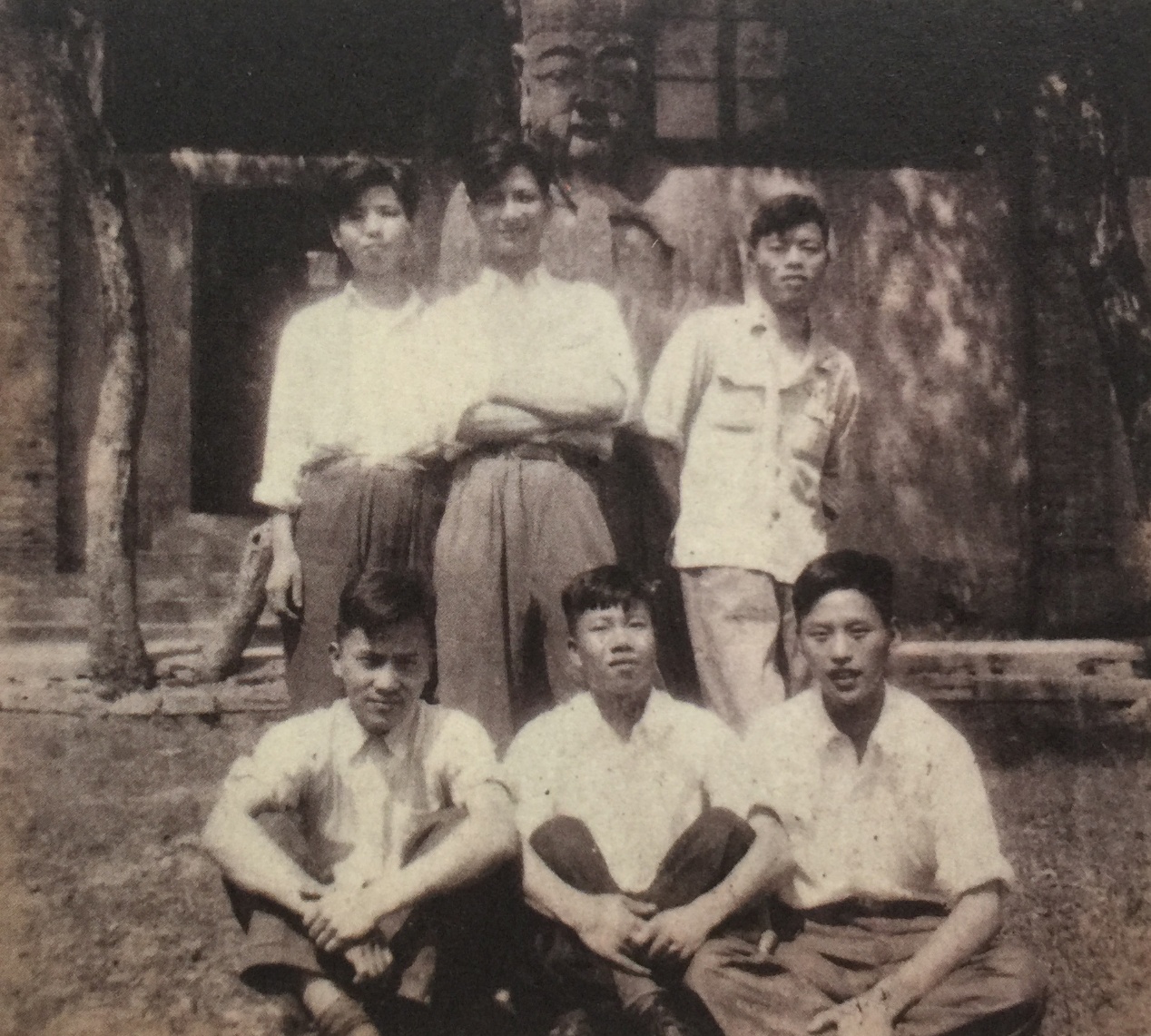
Group photo of Wen Lianchang (center, front row) with Ma Zhengrong (right, front row) and other classmates at the National Hangzhou Art College
Due to his outstanding performance, Wen was invited to teach at the college after graduating in 1951 and became one of the first postgraduate students at the East China Branch of the Central Academy of Fine Arts (CAFA) after the founding of the People's Republic of China. In early 1953, as part of the effort to establish the Central Academy of Arts & Design, Wen moved to Beijing with the faculty and students of the Department of Applied Arts to merge into the corresponding department at the CAFA. Equipped with profound skills in pattern design and comprehensive artistic training, he quickly immersed himself in design projects for national development. His distinguished contributions are evident in many significant designs, including the Capital Theatre, the Soviet Exhibition Hall (today’s Beijing Exhibition Center), the Three Major Medals, and the “Marshal Uniforms.”
In 1956, with the establishment of the Central Academy of Arts and Design (today’s Academy of Arts & Design, Tsinghua University), Wen took part in its founding and became one of the institution’s inaugural faculty members, primarily teaching courses in fundamental pattern design, machine-printed textile design, and carpet design.
By the end of 1958, under the leadership of Vice President Lei Guiyuan, he joined the design team for Beijing’s “Ten Great Buildings” as a core member. Thanks to his expertise in decorative patterns, Wen played a key role in the interior and decorative design of several major projects, including the main auditorium carpet, silk curtains, and brocade sofa fabrics in the Great Hall of the People, the bronze decorations in the entrance hall of the National Museum of China, the grand wrought-iron floral screen in the Cultural Palace of Nationalities, and the carpets for the Diaoyutai State Guesthouse. In particular, he independently designed carpets for multiple prestigious spaces, including the auditorium and Beijing Hall in the Great Hall of the People, corridors in the National Museum of China, and some guest rooms in the Diaoyutai State Guesthouse and the Prime Hotel Beijing (today’s Empark Prime Hotel Beijing).
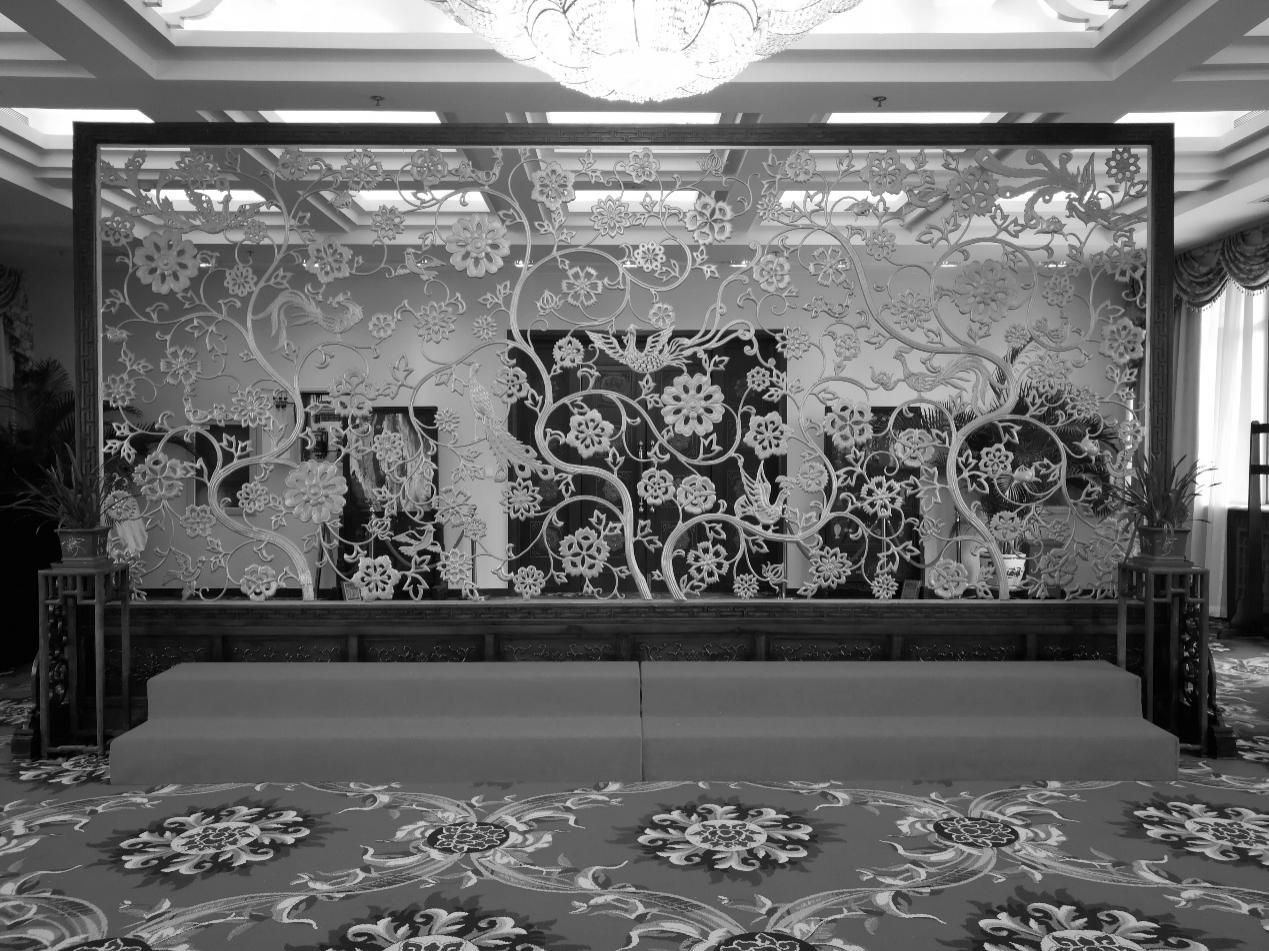
“Auspicious Harmony”, grand wrought-iron floral screen at the Cultural Palace of the Nationalities, designed by Wen Lianchang in 1959, measures 247cm high and 465cm long. Originally part of a screen in the dance dining hall of the west wing, it is now displayed in the multifunctional hall on the third floor of the main building. (Photo by Li Yang from Cultural Palace of the Nationalities and provided by Ji Hongmei)

Bronze decoration in the entrance hall of the National Museum of China, designed by Wen Lianchang in 1959
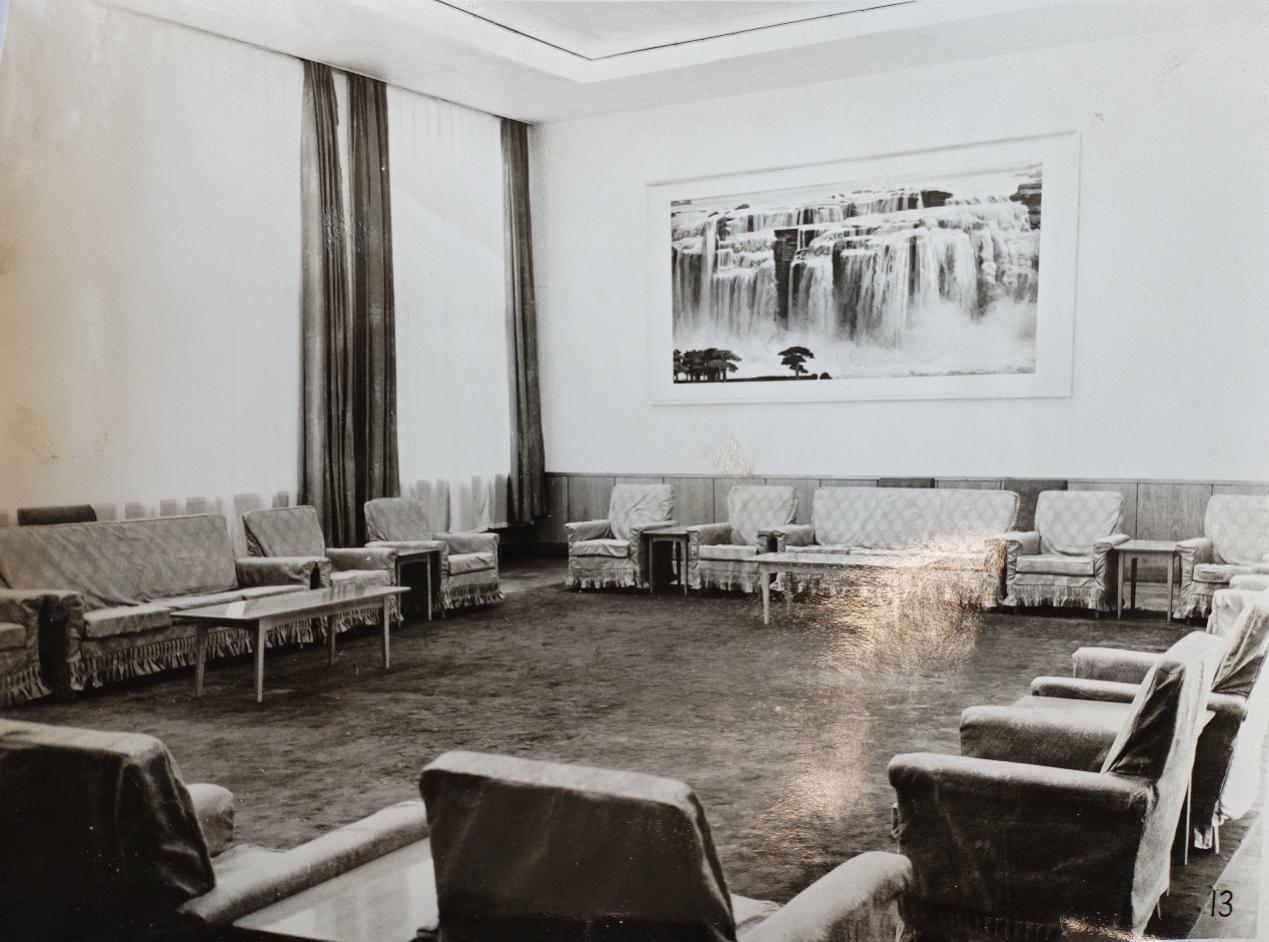
1979 VIP Lounge Interior, Terminal 1, Beijing Capital International Airport, featuring the acrylic mural “The Yellow River Flows from Heaven” on the wall (Photo by Li Hongyin, painted by He Shan, and carpet design by Wen Lianchang)
“Every pattern, every page of sketches, every design was the fruit of collective wisdom and hard work,” Wen recalled. Despite the heavy workload and tight deadlines, the entire team gave their all. Following the “three simultaneous principles”—designing, constructing, and revising all at once—they lived and worked on the construction site for months. To facilitate late-night drawing sessions, they even replaced the light bulbs with brighter 150-watt ones. When designing the grand wrought-iron floral screen for the dining hall of the Cultural Palace of the Nationalities, Wen drafted 18 individual patterns in the back of a rundown open-air truck, later assembling them on a sports field into a magnificent scene of “a hundred flowers in bloom.”
While working on the decorative designs for the “Ten Great Buildings,” Wen was never content with proposing just one solution. Where others offered one design, he would always prepare two or more alternatives. As a result, his creative ideas often found their way into the final implementations. Such ability was nurtured by Mr. Lei Guiyuan’s philosophy of “sketching from nature and artistic variation,” which enabled him to master traditional styles while pioneering modern design. With his brush, Wen not only helped write a glorious chapter in the People's Republic of China’s design history, but also expressed his profound devotion to national development.
Design for education and teaching
While deeply involved in the designs for Beijing’s “Ten Great Buildings,” Wen Lianchang, in his role as a faculty member of the Central Academy of Arts and Design, seamlessly integrated textile art design education with the practical needs of decorative and interior fabric design for these landmark projects. As noted in the Collected Works of Wen Lianchang (edited by Jia Jingsheng, Shandong Fine Arts Publishing House, 2020), Wen Lianchang “pioneered a new model of integrating textile art design education with practical design in China and helped shape the aesthetic style of Chinese textile art and design.” Reflecting on the decorative screen design for the Cultural Palace of the Nationalities, Wen shared: “At the time, the Academy also assigned a group of students to assist me with the ‘Hundred Flowers in Bloom’ project. This design project was part of my job, along with teaching courses.”
Professor Jia Jingsheng of the Department of Textile and Fashion Design at the Academy of Arts & Design, Tsinghua University, once wrote: “As a master in textile design education, Mr. Wen Lianchang taught undergraduate and graduate students as well as short-term training classes within the academy. He also conducted professional development programs for faculty from universities across the country and led training sessions for designers in textile enterprises nationwide. He effectively integrated education into society, deepened its presence in industries, connected it with the market, and bridged it with the world.”
The courses taught by Wen covered a wide range of subjects, including foundational classes such as life drawing, basic pattern design, pattern colors, and pattern techniques, as well as specialized design courses like printing, woven design, embroidery, carpet design, and fiber art creation. He once advised young teachers: “An outstanding educator must demonstrate with example works, provide live demonstrations, supply teaching materials, understand craftsmanship, excel in production, and possess both rich design experience and practical design skills.”
From 1980 to 1991, Wen served as the dean of the Textile Department at the Central Academy of Arts and Design. Under his leadership, the department developed a structured curriculum and teaching syllabus for pattern design, systematically organizing pattern types, construction methods, modeling principles, and application techniques. He established printing and dyeing labs, weaving workshops, and an archive of ethnic patterns. By integrating the educational philosophy of “learning from tradition while drawing inspiration from nature” with practical experience, he charted a clear direction for the teaching and research of pattern design.
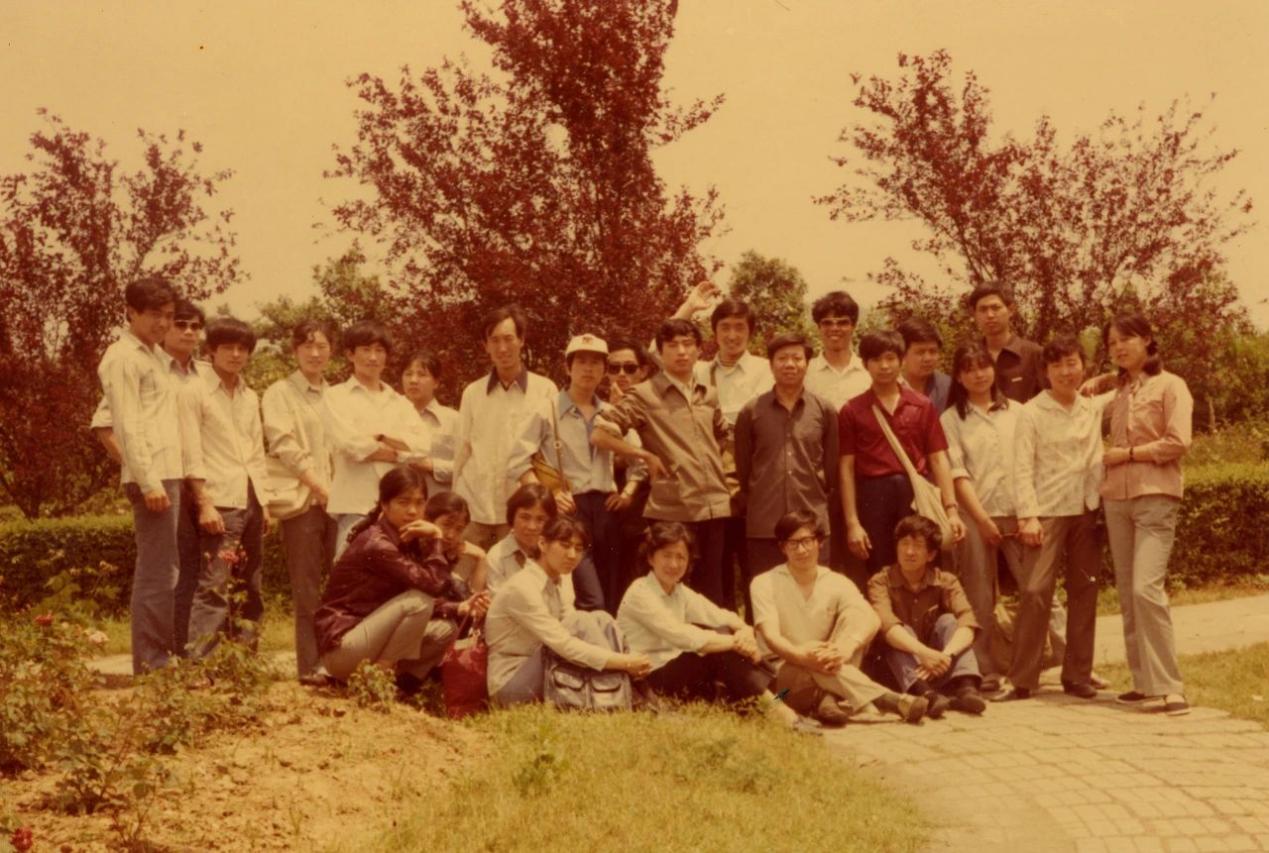
Group photo of Class 77 from the Textile Department led by Wen Lianchang and Chang Shana for internship in Hangzhou during the summer of 1981
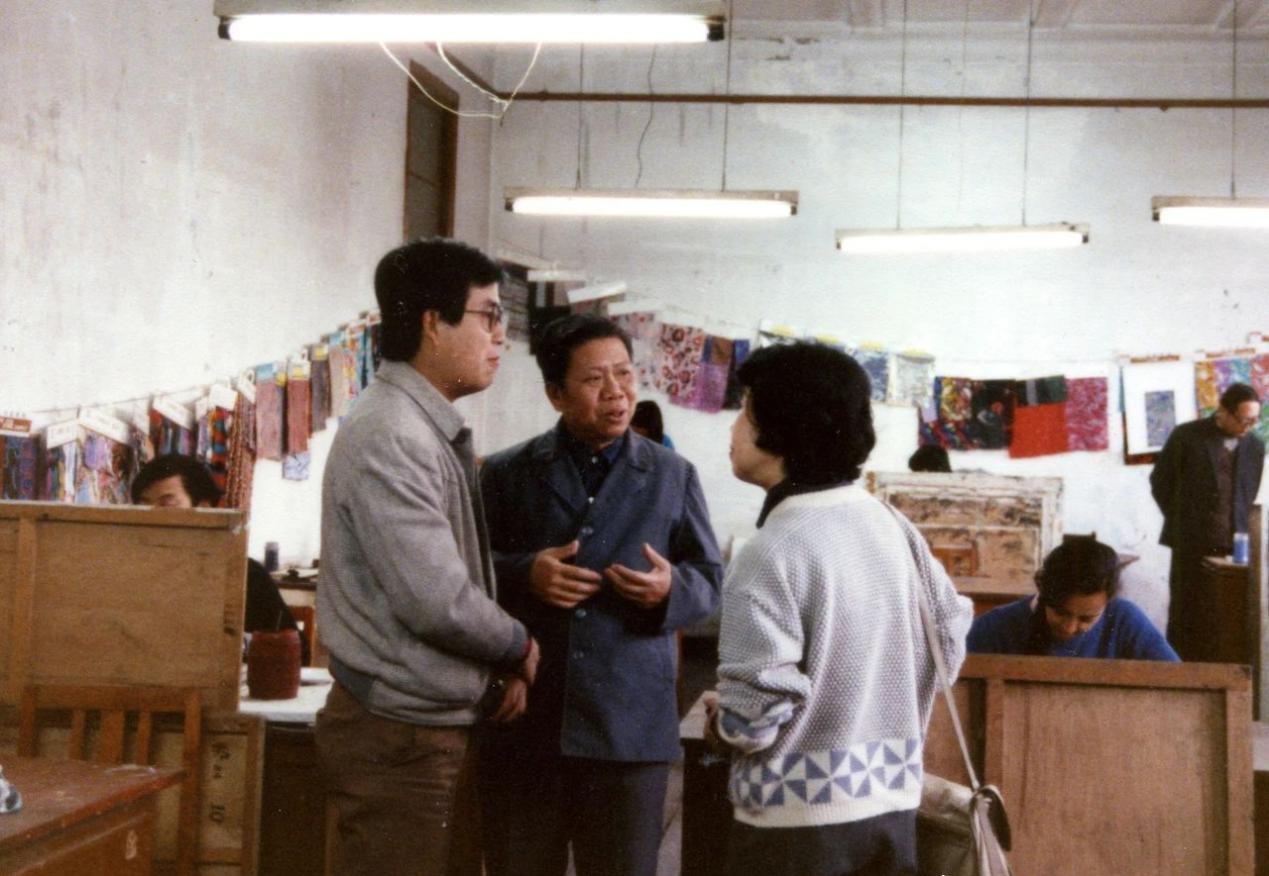
Wen Lianchang with visiting professors from Musashino Art University in a classroom in November 1987
During his tenure at the Central Academy of Arts and Design, Wen not only pioneered courses in pattern techniques, sketching and variation, and silk woven design, but also compiled and published a series of foundational textbooks—many of which became standard references in China’s textile art and design education. Among his influential works are The Transformation of Flowers, Fundamentals of Textile Pattern Design, Sketching and Variation: The Collected Works of Wen Lianchang, and Black-and-white Floral Illustration. He once remarked: “Throughout my life, I have followed Mr. Lei Guiyuan’s path, persistently studying and creating patterns. Though I was not formally trained as a pure painter, I developed strong painting skills.” This dedication became the driving force behind his lifelong commitment to education in textile design.
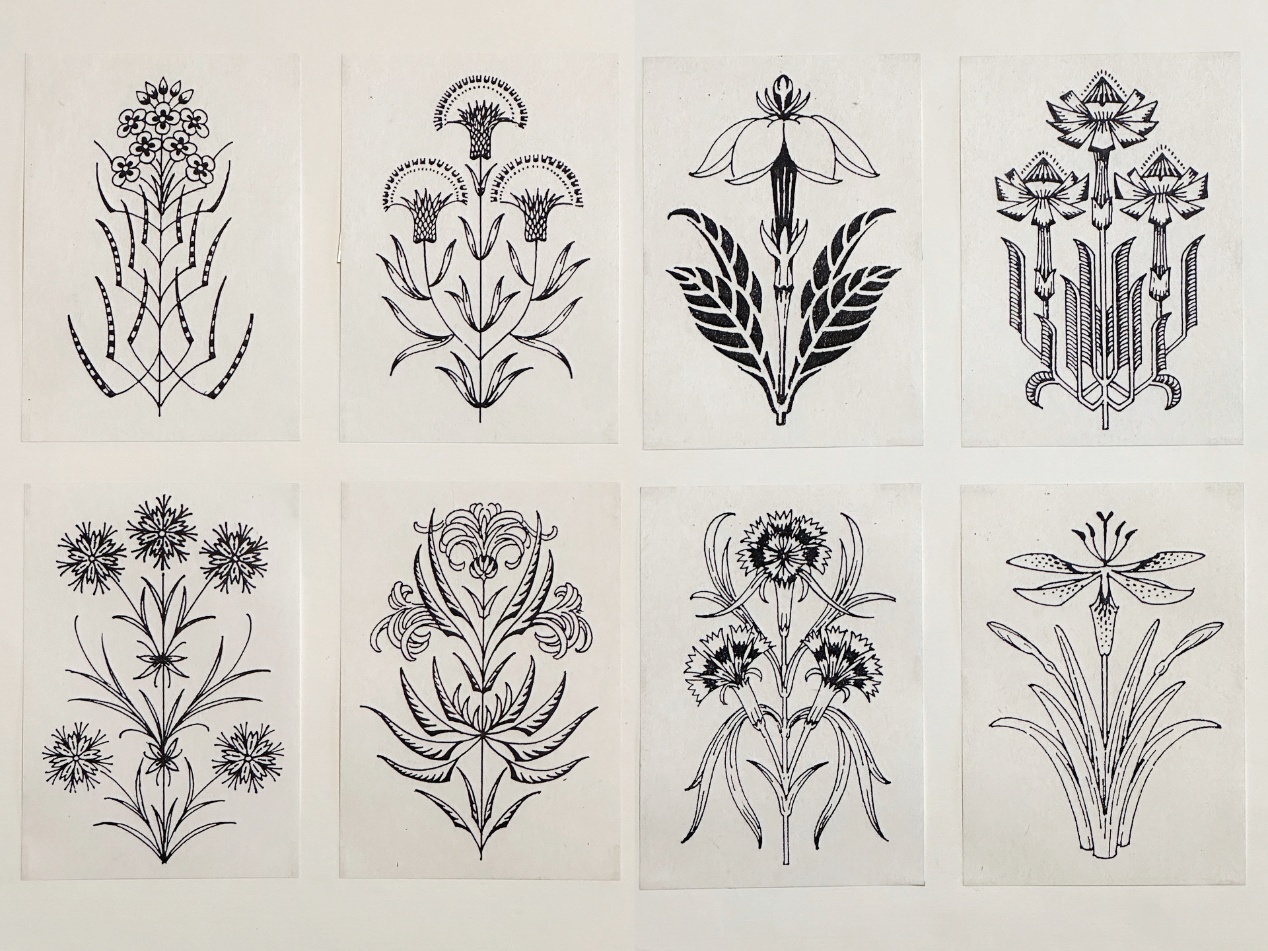
Independent pattern designs (black and white, line drawing) by Wen Lianchang
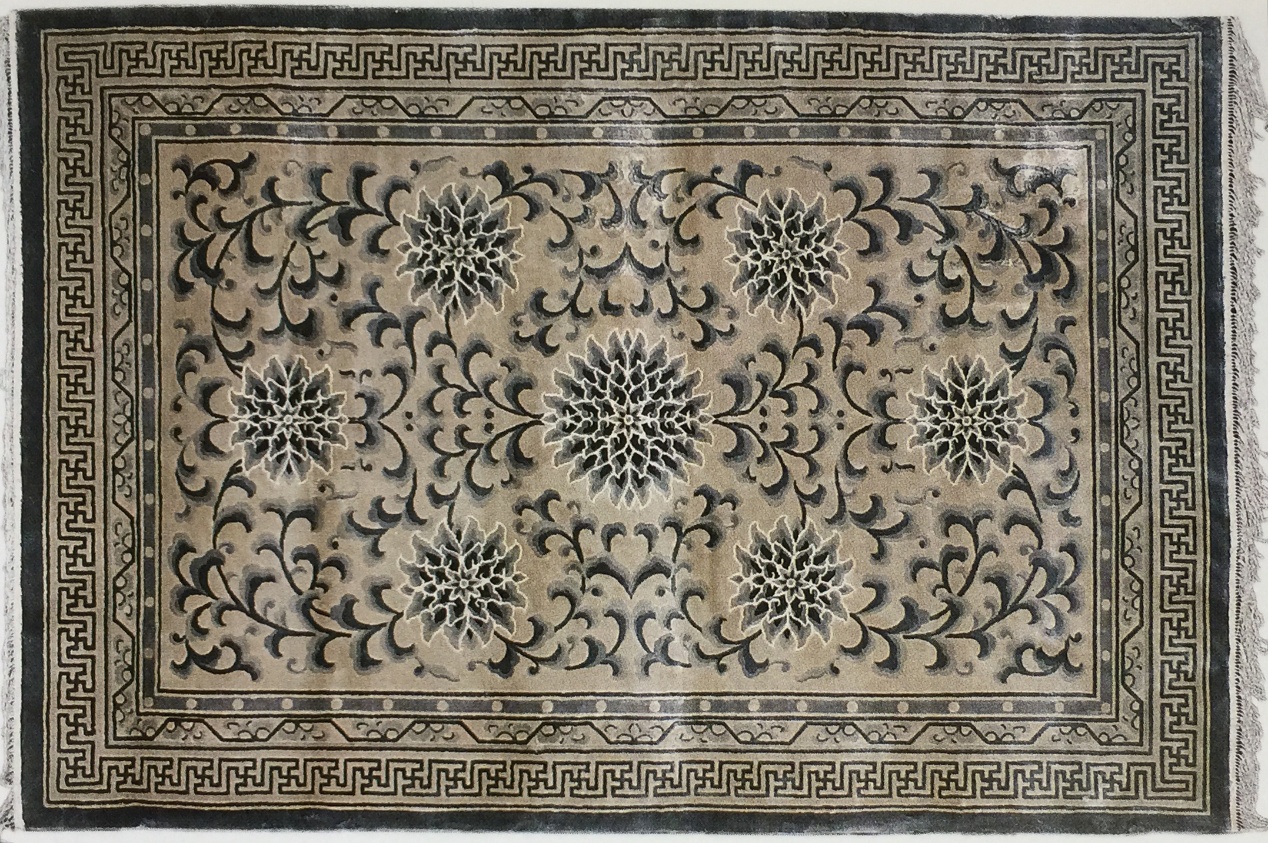
Lotus Medallion Silk Tapestry (122 × 195 cm) designed by Wen Lianchang exhibited at The 5th National Arts & Crafts Exhibition and The Modern Chinese Decorative Arts Exhibition (Textiles & Ceramics) in Hong Kong
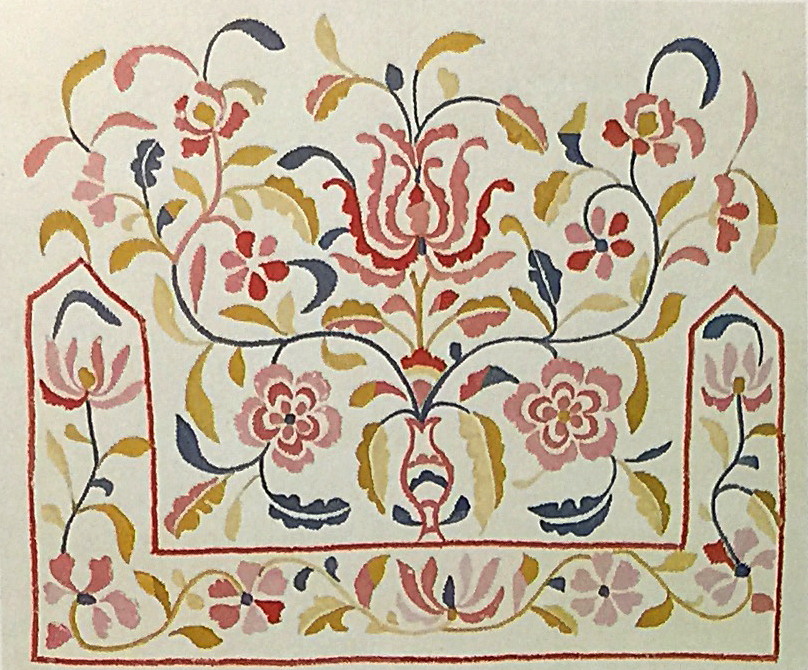
Floral handkerchief in Kashgar of Xinjiang, copied by Wen Lianchang in 1961
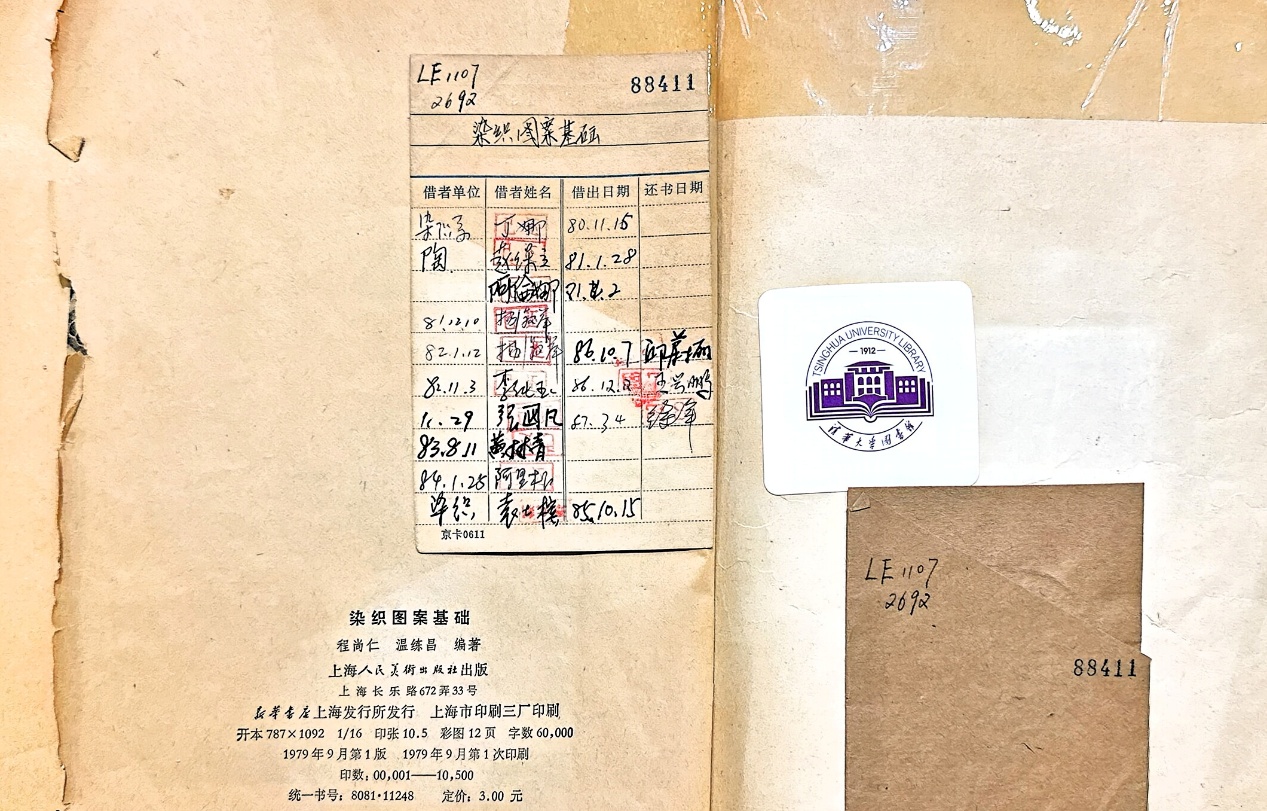
Fundamentals of Textile Pattern Design compiled by Cheng Shangren and Wen Lianchang and the original library card in the Tsinghua University Library
Regardless of his great achievements in art and design, Wen always considered teaching his fundamental vocation. In an interview during the “Commemorative Events for the 110th Anniversary of Mr. Lei Guiyuan’s Birth,” he remarked: “Mr. Lei Guiyuan referred to himself throughout his life as ‘a teacher by trade.’ Even Mr. Xu Beihong, in his later years, said, ‘First and foremost, I am a teacher; only then am I a painter.’”His words reflect not only deep respect for his predecessors, but also a lifelong commitment to education.
Design for cultural heritage
Architecture is a frozen epic, etching the annals of a city; culture is a flowing lifeblood, nourishing the soul of a city. Born at the dawn of the People’s Republic of China, Beijing’s “Ten Great Buildings” gleam like ten brilliant pearls, blending modern aesthetics with national tradition. At the very beginning of the “Ten Great Buildings” project, Premier Zhou Enlai set forth the guiding vision of “national, scientific and popular” designs. At the time, design was more a responsibility and a mission than an artistic endeavor. Every participant strived to infuse each detail with profound love for their homeland.
Most of Wen’s designs bear a distinct imprint of traditional and national culture. For instance, in carpet design for Diaoyutai State Guesthouse, he drew inspiration from lotus medallion patterns in the Tang Dynasty (618-907). In the decorative design for National Museum of China, he incorporated symbolically rich elements such as red stars and wheat ears. In the 1970s, his peony-patterned wallpaper designed for the Beijing Hotel was selected for use in several halls of the Great Hall of the People. “The decorative patterns I designed for the Cultural Palace of the Nationalities were initially inspired by a research trip to Xinjiang,” Wen recalled. He skillfully integrated ethnic patterns from Xinjiang with modern architectural style, creating a decorative scheme that was both culturally distinctive and contemporary in expression.
Through such artistic dedication, traditional Chinese patterns that have endured the tests of time have become a vital part of China’s cultural heritage and a visual embodiment of its material civilization.
As early as the 1950s, Wen began recreating a series of textile patterns based on classic silk artifacts in the Ming Dynasty (1368-1644)—specifically, covers of Buddhist sutras—through meticulous study and authentic hand-drawn replication. Among his reproduced works were satin patterns such as the silver camellias against an azure ground, lotus and peony against dark blue ground, and others.
In 1961, he led a research team from the academy’s Textile Department on an expedition to Kashgar, Hotan, Lop County, and other regions in Xinjiang, where they conducted systematic research and documentation of local folk textile and embroidery patterns. The team produced hand-copied records of numerous precious ethnic and folk patterns, culminating in the publication of their findings in the book Folk Textile and Embroidery Patterns of Xinjiang (《新疆民间染织刺绣图案》).
In 1970, apart from intense manual labor, Wen devoted his spare time to grassroots research, visiting over twenty folk painters and embroidery experts. He collected, organized, and illustrated a large number of traditional pillow embroidery patterns, eventually designing more than 300 pillow patterns for local use. These were later published in the Collection of Folk Pillow Patterns (《民间枕花图集》).
In 2004, Wen Lianchang served as chief editor and author for the Complete Works of Chinese Fine Arts: Corpus of Chinese Fabric, Embroidery and Finery—Dying and Weaving. This landmark publication offers a developmental history of the craft, richly illustrating treasured weaving and dyeing works across Chinese history. The volume contains approximately 30,000 characters and 567 images of historical artifacts selected from both archaeological finds and inherited treasures dating from 1000 BCE to the early 20th century based on their artistic value and pattern integrity. Through his lifelong dedication to the study of pattern design, Wen played a pivotal role in preserving, inheriting, and innovating the Chinese school of pattern studies, building a bridge between tradition and modernity.
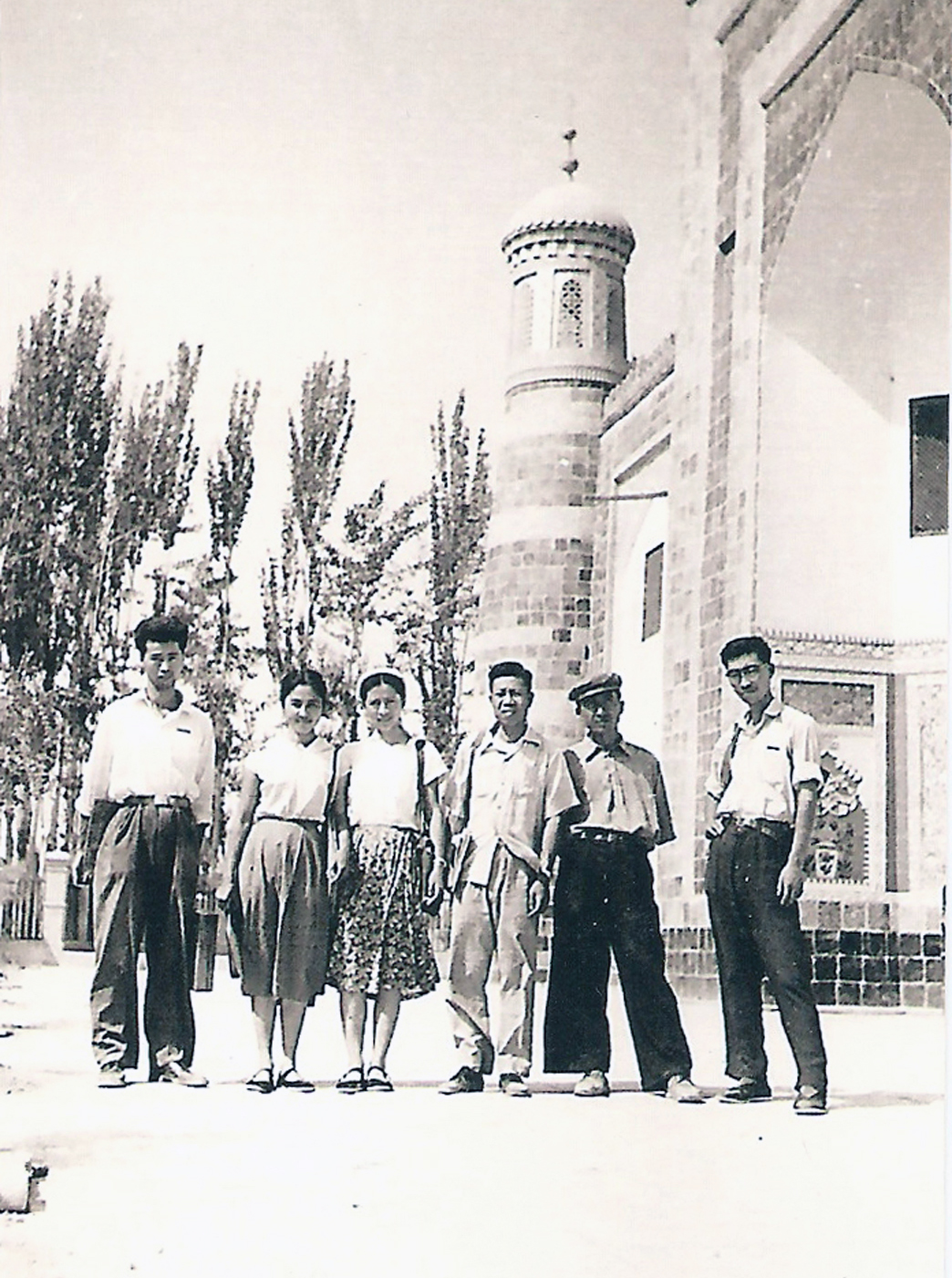
Group photo of the Textile Department faculty members during the survey of folk textile and embroidery patterns in Xinjiang in 1961
From left: Li Yongping, Yuan Jieying, Chang Shana, Wen Lianchang, Yunus (Trainee from Xinjiang), Zhu Junshan
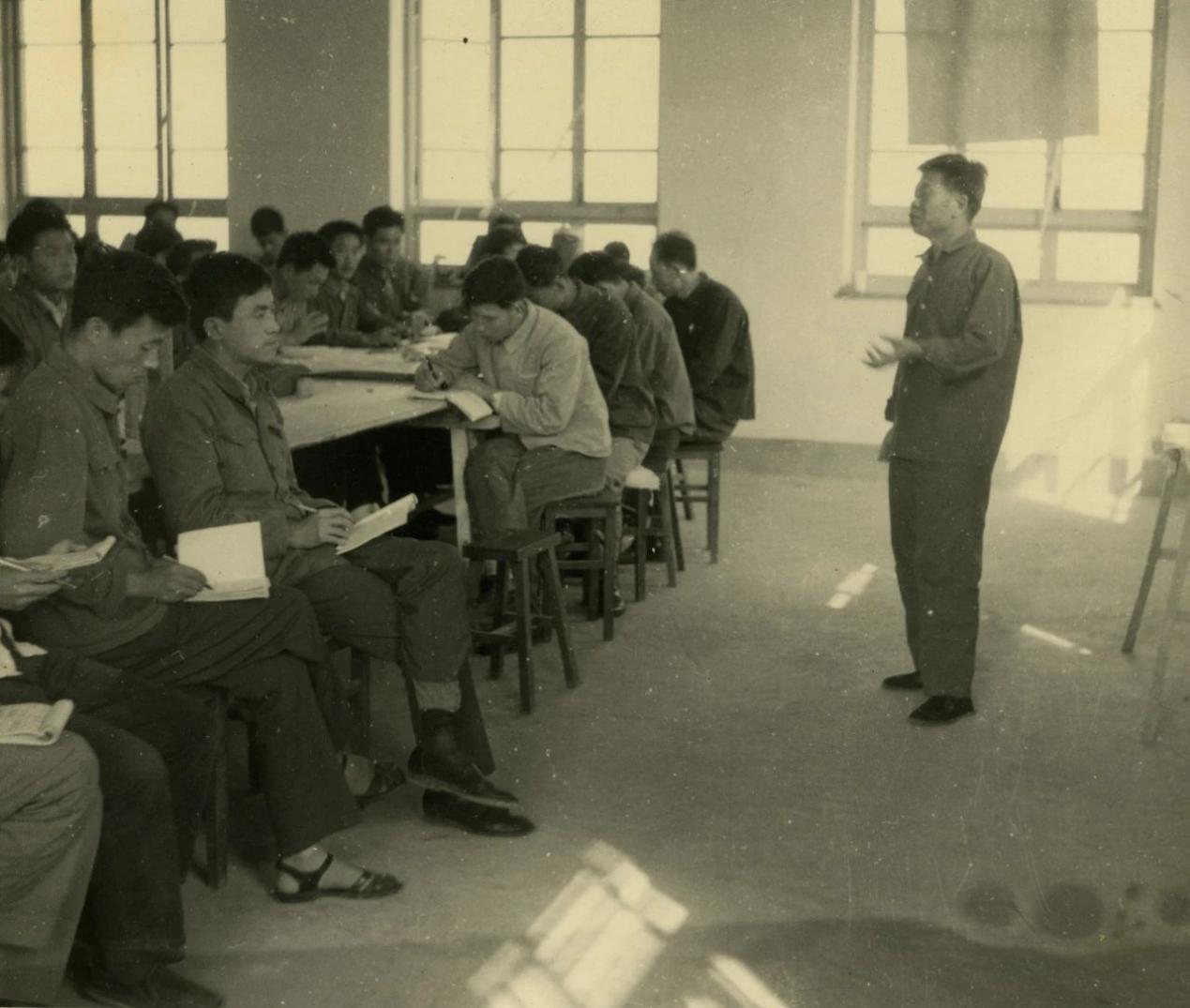
Wen Lianchang lecturing for textile designers in Shidao, Shandong Province in 1975
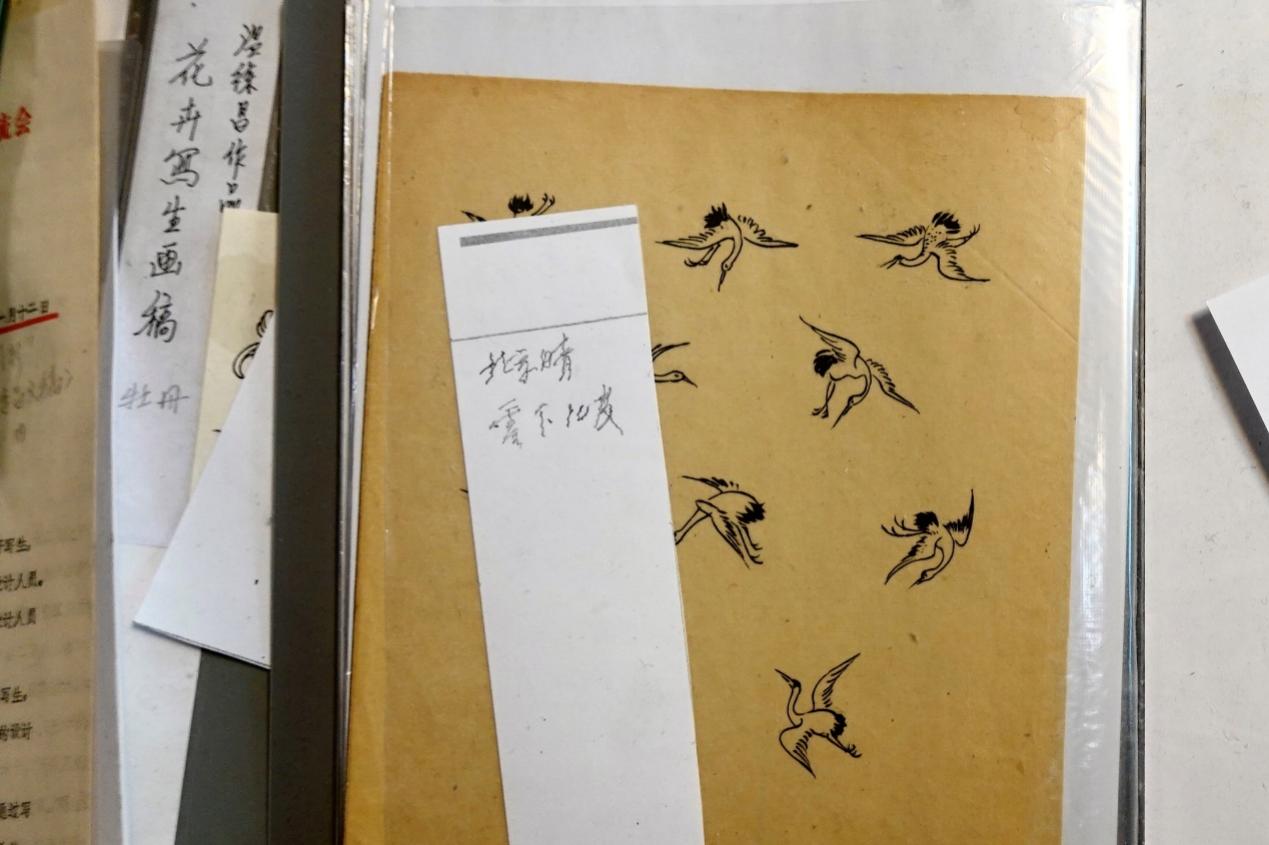
Manuscripts preserved by Wen Lianchang

Selected works by Wen Lianchang in the Tsinghua University Library
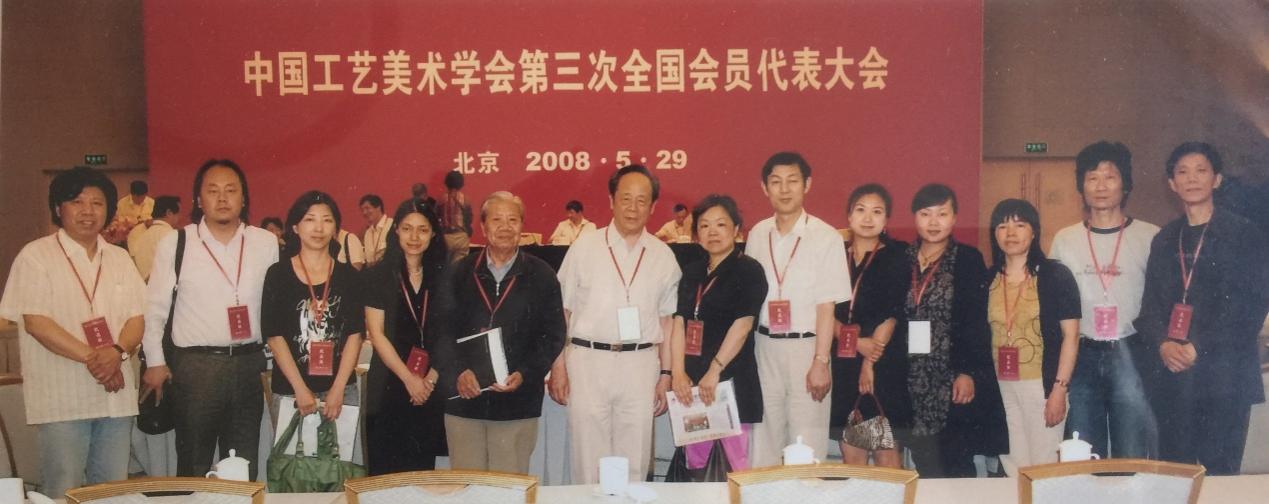
Wen Lianchang at the 3rd National Congress of the China National Arts & Crafts Society in May 2008
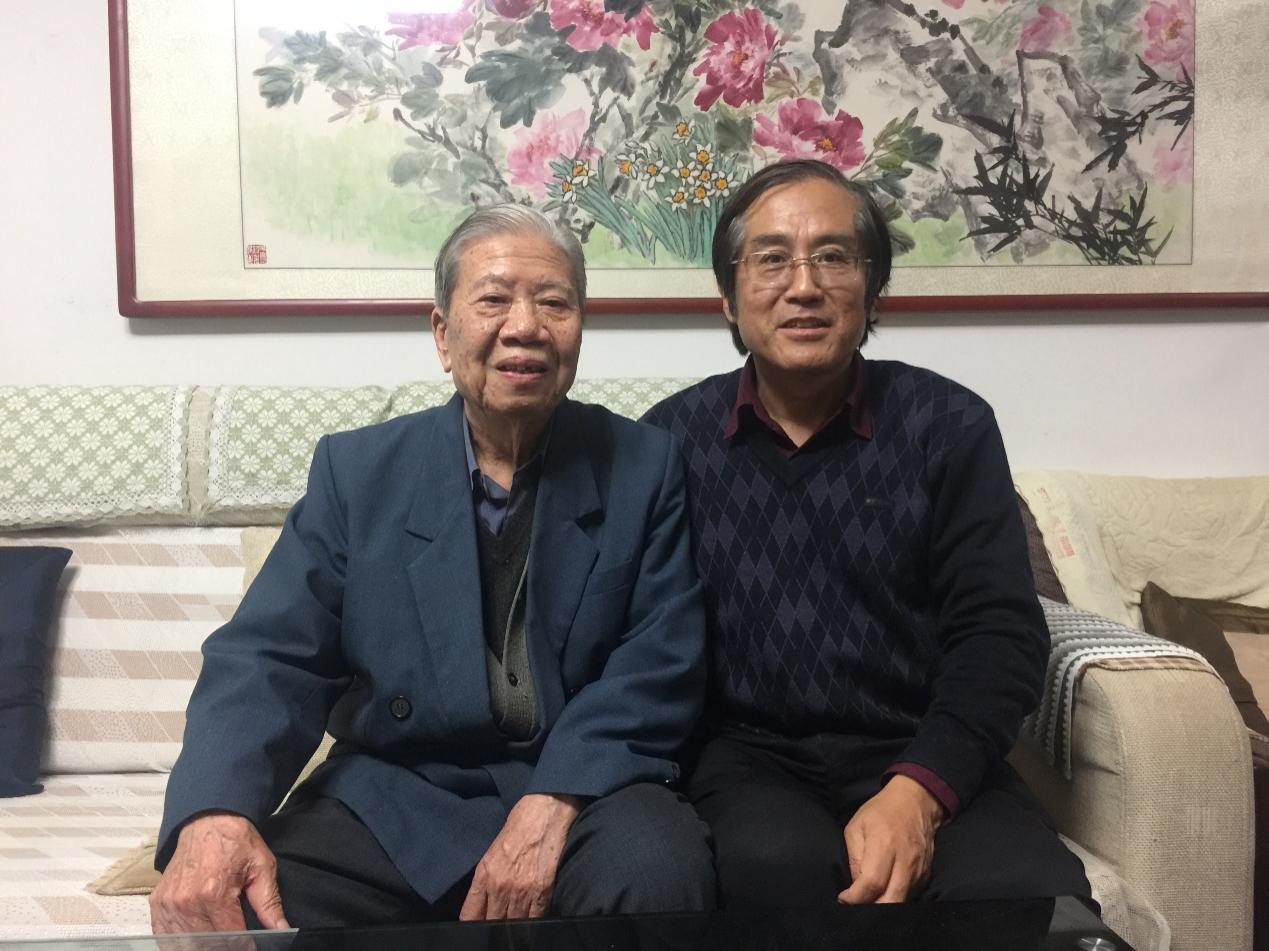
Jia Jingsheng’s interview with Wen Lianchang for the compilation of Collected Works of Wen Lianchang in November 2016
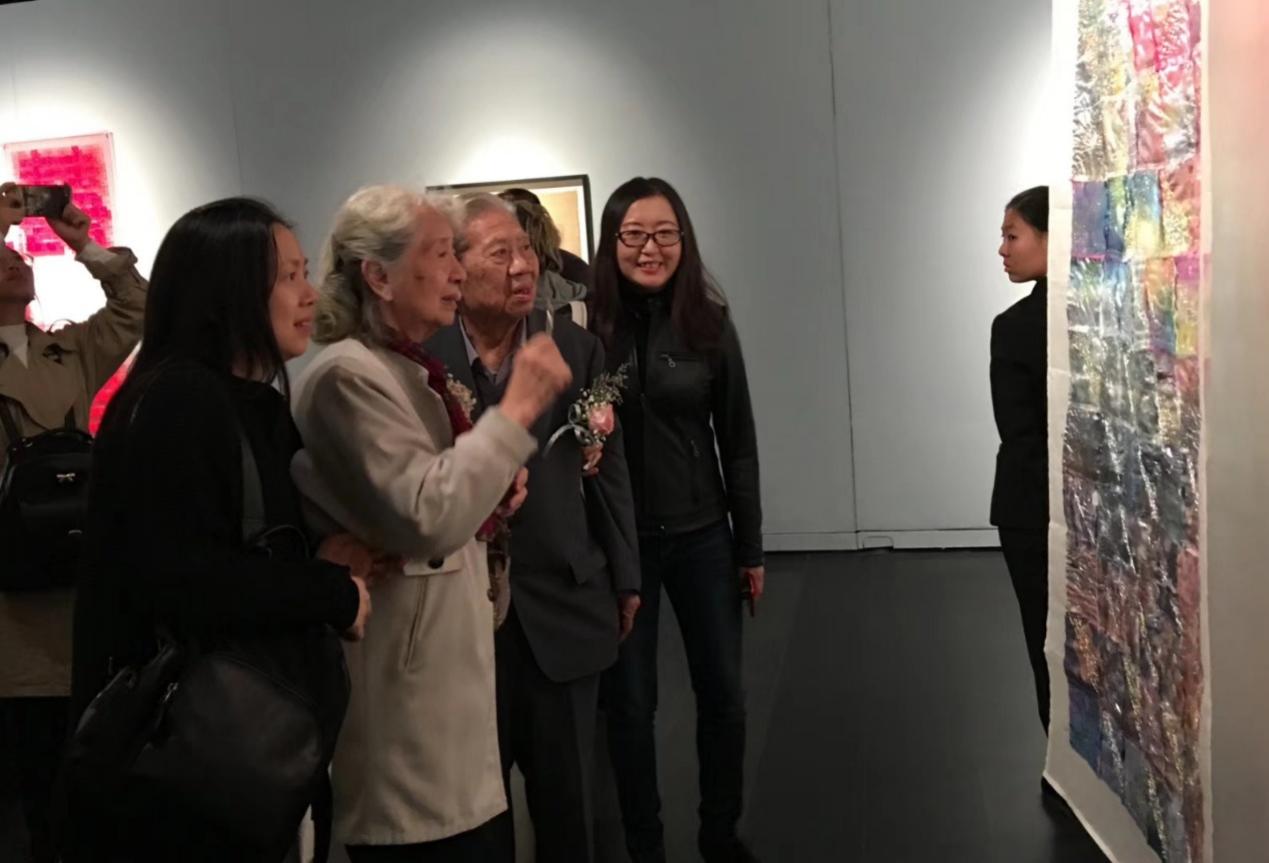
Wen Lianchang and Chang Shana appreciating the work by students Jiang Shouxiang and Sun Shu during the “From Lausanne to Beijing” International Fiber Art Bienniale held at the Tsinghua University Art Museum in October 2018.
From the silk curtains of the Great Hall of the People to the grand wrought-iron floral screen of the Cultural Palace of Nationalities, what Wen Lianchang wove with his life’s effort was not merely a series of patterns, but a flowing epic of national aesthetics.
At the intersection of tradition and modernity where art meets everyday life, Wen Lianchang’s lifelong practice demonstrates one enduring truth: True design is ethnic identity engraved in time; it is cultural awakening woven into daily existence; it is a spiritual dialogue that transcends time and space.
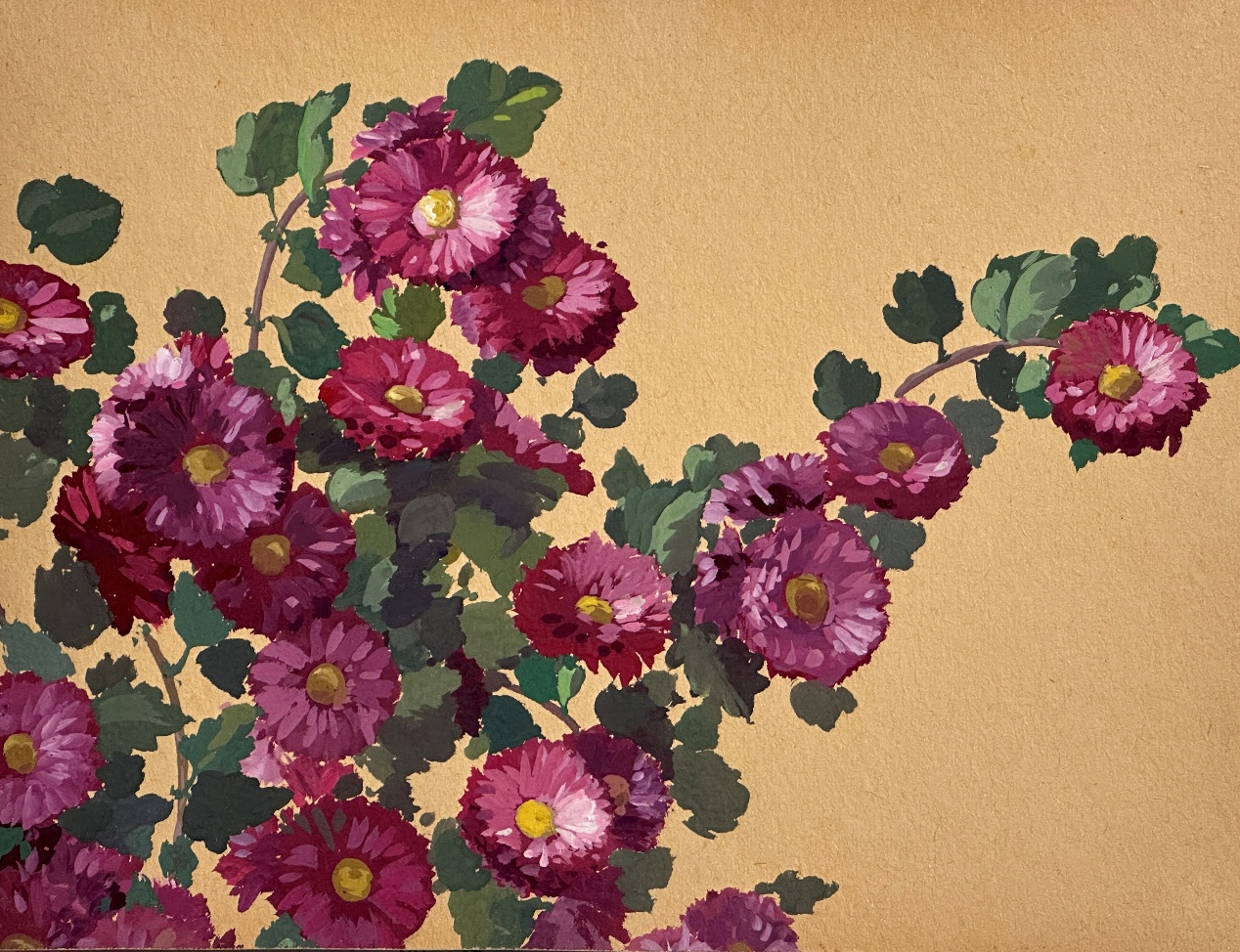
Cliff Chrysanthemums (red flowers on yellow ground, horizontal composition) painted by Wen Lianchang
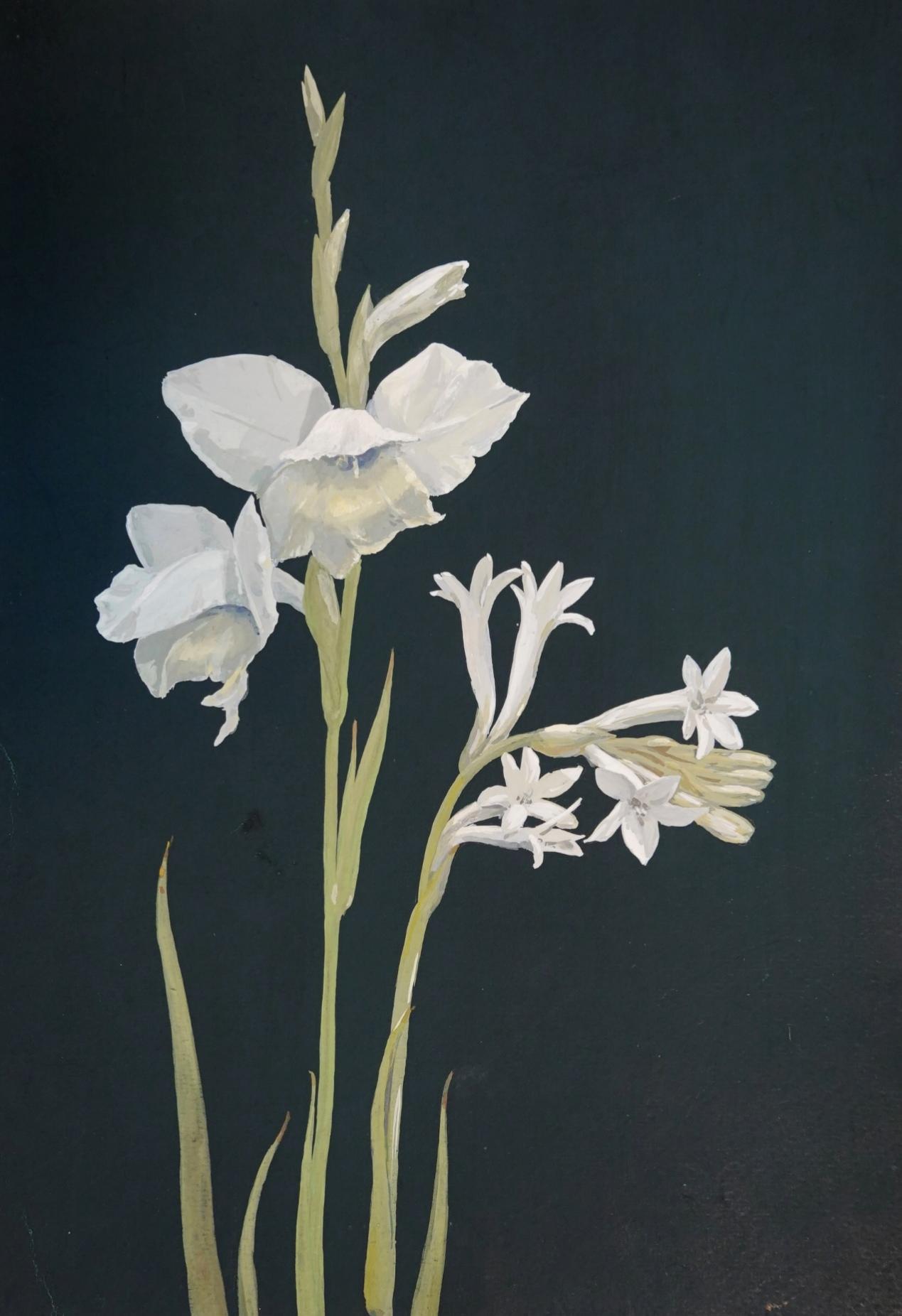
Iris (white flowers on dark gray ground, vertical composition) painted by Wen Lianchang
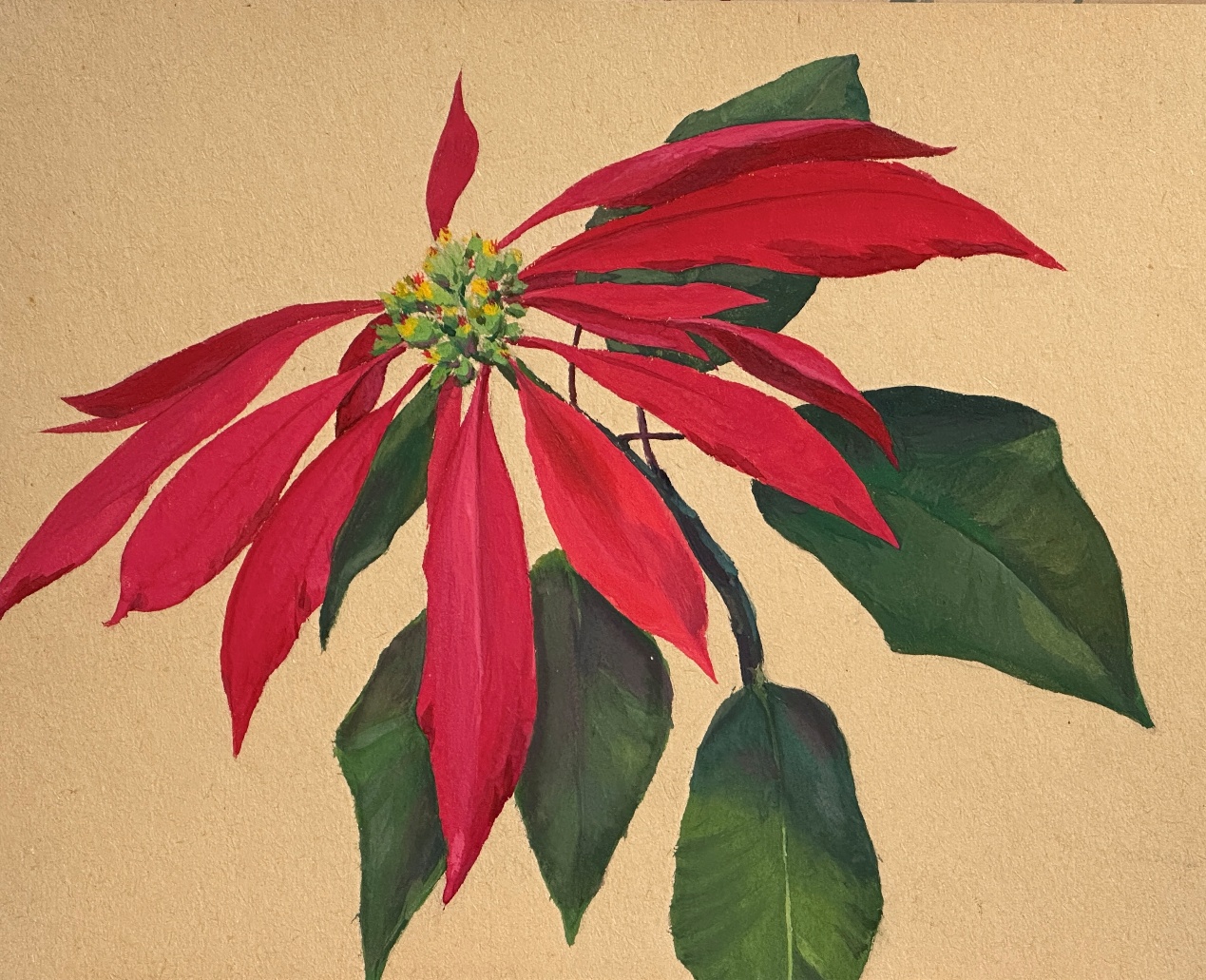
Poinsettia (red flowers on yellow ground, horizontal composition) painted by Wen Lianchang
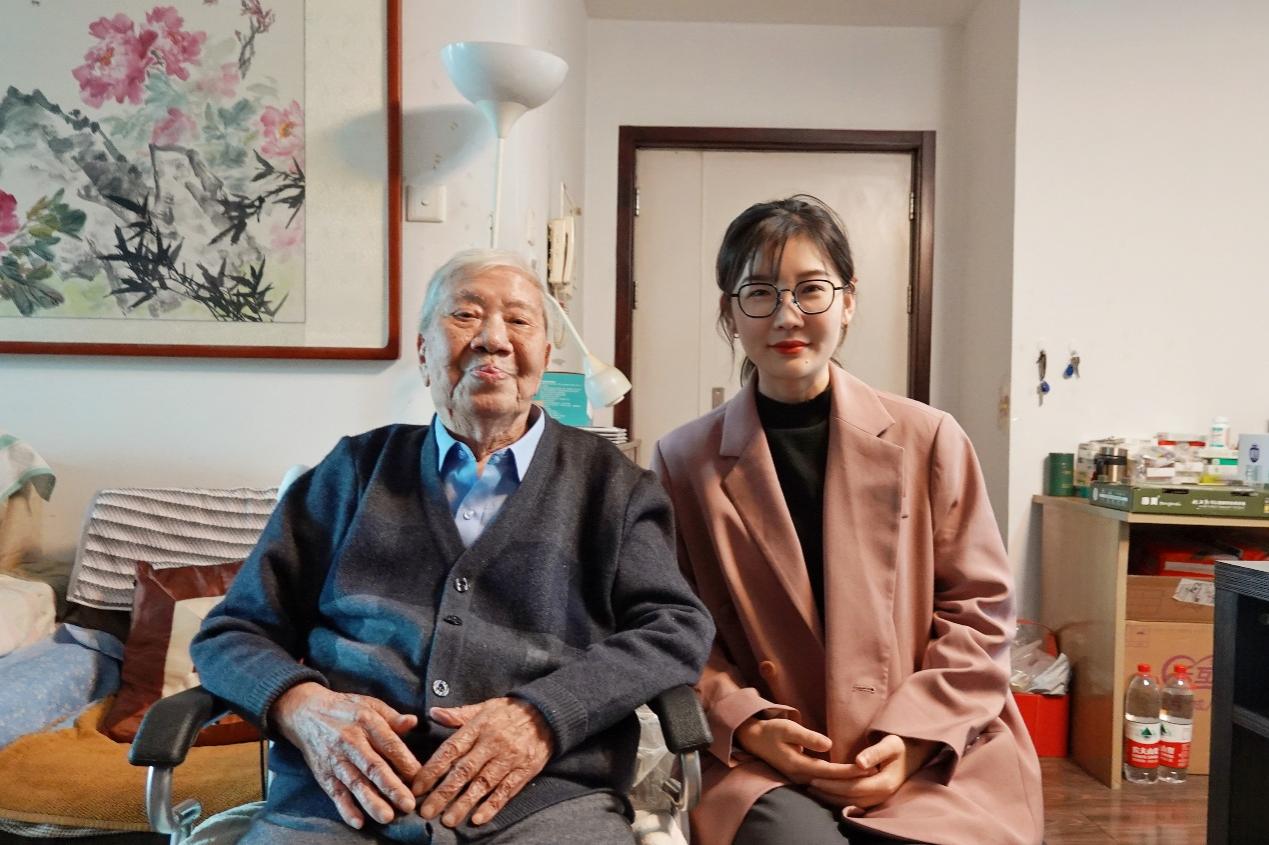
Photo with Mr. Wen Lianchang during the interview
Special thanks to Jia Jingsheng, Guo Qiuhui, and Zhang Jingsheng for their review of this article.
窗体底端
Produced by | Converged Media Center, Academy of Arts & Design, Tsinghua University
Planning & Coordination | Chai Xinmeng
Interviews & Copy Editing | Chai Xinmeng
Written by | Jie Mingyue
Images courtesy of | Zhang Jingsheng
Video by | Luo Yumeng
Graphics Editing | Chen Jie, Luo Xuehui
Reviewed by | Wang Xiaoxin

